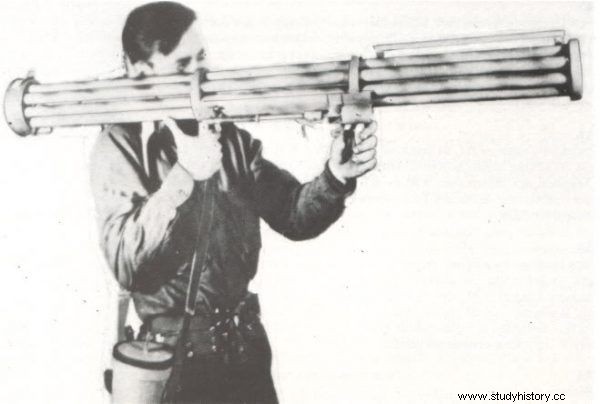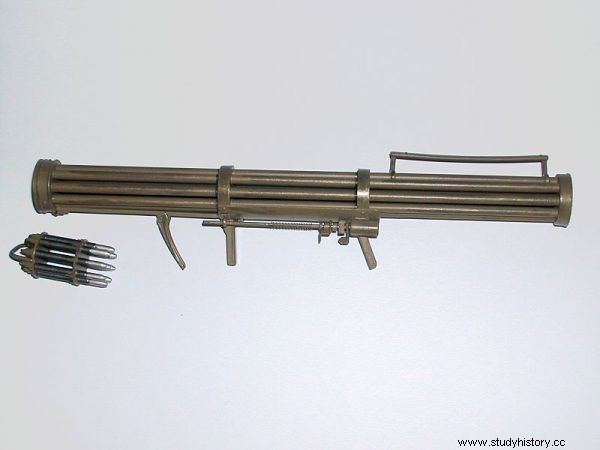During World War II, German engineers performed miracles to counterbalance the technological and, above all, quantitative advantage gained by the Allies from 1943. Wehrmacht and SS soldiers received panzerfausts - effective anti-tank grenade launchers to fight the Soviet tanks. Reports of hundreds of tanks destroyed by panzerfausts inspired Hitler to demand the creation of a similar anti-aircraft weapon. And such a weapon was created! It was called "fliegerfaust". Have you heard of something like this?
Anyone interested in the history of the Second World War has heard of a panzerfust - a German anti-tank grenade launcher. It was the response of the German arms industry to the requests of soldiers fighting on the Eastern Front. They demanded that weapons be provided that would allow them to stop the Soviet tanks . If on a given section of the front there were at least a few Tigers or Panthers, anti-tank guns or anti-aircraft guns "acht koma acht", the Germans were able to hold their position for weeks or even months. It was harder to stop "Ivan" where there were no anti-tank weapons. And due to the great length of the front, there were a lot of such places.
Pancerfaust goes to the front
So the engineers of the Third Reich quickly developed a simple anti-tank weapon - the Panzerfausta. The first copies hit the front in 1943. It was a weapon, weighing about 5 kg, operated by a single soldier. It consisted of a metal tube containing a propellant charge and a cumulative head, stabilized by wings unfolding after firing. The principle of the Panzerfaust was very simple:the gunpowder charge fired a HEAT warhead that was heading towards the tank. If it hit, it pierced the armor and killed the crew inside. The tube from the fired panzerfaust was abandoned by the soldier on the battlefield.

Soldier with Panzerfaust, Ukraine, December 1943.
Until the end of the war, several types of panzerfausts were developed:"Klein", "Gross", "60", "100", "150" and "250", where the numbers denoted the effective range of the weapon given in meters. The late-war 250m panzerfausts were the prototypes of the RPG (hand-held anti-tank grenade launchers) used in many armies. The RPGs used, for example, in the Polish Army in the 1980s and 1990s looked and functioned exactly like pancerfaust 250.
The abandonment of steel panzerfaust launchers was not welcome due to the dwindling resources. So other solutions were sought. For example, soldiers were advised to collect steel pipes after a battle, which was usually not possible, however. In 1943, the Raketenpanzerbüchse 43 anti-tank missile launcher, working on a slightly different basis, was developed, later given the propaganda name "panzerschreck" - tank terror.
The Panzerschreck is terrifying
This weapon, using solutions taken from the captured American "Bazooka", was reusable. The loader put an 88 mm caliber missile into the launcher, armed it, and the sights, pressing the trigger, fired at a Soviet, American or British tank. Two soldiers serving "Panzerschreck" carried 10 missiles with them, so they had a better chance of destroying the enemy's armored car. The "Panzerschrecki", like the Panzerfausts, took a bloody toll on all fronts, and the soldiers praised them very much.
Hitler was delighted to hear about the possibilities of the Panzerfausts and Panzerschrecks. He demanded to increase the production and equip the front units with large amounts of these weapons. The huge scale of production is evidenced by the fact that during the fighting for Poznań in 1945, the Russians intercepted a train with over 25,000 panzerfausts! Total production of these weapons by the end of the war is estimated at 6.7 million pieces.
The Allies managed to capture thousands of Panzerfausts and Panzerschrecks. They have been subjected to thorough technical tests, and the most interesting technical solutions have been copied and used in various types of weapons. The universality of the panzerfaust is evidenced by the fact that for several years after the war, about 5,000 captured panzerfausts were "in stock" in the Polish People's Army. Polish military engineers also created an anti-tank grenade launcher based on solutions taken from the pancerfaust.
Hitler's flying fist
Similar success was expected with the "flying panzerfaust", designed and manufactured towards the end of the war as a "last resort" weapon. The originator was allegedly Adolf Hitler himself, who, inspired by reports on the effectiveness of the panzerfausts, began to demand the creation of anti-aircraft weapons operating on a similar principle. He wanted to give his troops a weapon that would allow them to shoot down the Soviet "Stormtroopers" and the American Thunderbolts that were attacking them from low altitude.
During this period of the war - 1944 - the Allies had already achieved absolute superiority in the air. Weather permitting, American and British planes attacked German field fortifications, armored columns, and trains carrying military transports from a low ceiling. The same happened on the Eastern Front, where the terror of the Germans was caused by the Soviet "flying tanks" of the Il-2 and Il-2m3 type. The idea for the anti-aircraft armored carfaust was obvious, so the implementation of Hitler's idea began.

Fliegerfaust
Despite the ongoing bombing of industrial centers and the slowdown in production throughout the Reich, in early 1945 engineers from Hugo Schneider AG managed to develop the expected weapon called "Luftfaust A". The design and implementation works lasted only a month! The Luftfaust A consisted of a set of four tubular launchers, similar to those used in the panzerfust. The pipes were placed one above the other, so the weapon resembled a radiator. Four modified (converted into rockets) caliber 20 mm shells were fired from the launcher. Firing was carried out from the shoulder, and simple aiming devices were used to guide the missiles to the target.
This prototype weapon that fired surface-to-air missiles was quite inaccurate and unwieldy ( who would want to shoot a radiator? > ), a development version of the "Luftfaust B" was quickly developed. This invention consisted of nine tubes 130 cm long. Eight pipes were arranged in a ring around the central, ninth. The missiles, more precisely the 20mm rockets, were fired alternately first from four and then from the remaining five barrels to balance the effect of the gunpowder gas and keep focus on the target. The effective range of the weapon was estimated at 500 meters, and the maximum at 1000 meters. So it was a weapon intended only for fighting low-flying targets, and this was what troubled the German infantry and grenadiers stuck in trenches and bunkers the most. After the first tests, a gigantic order for 10,000 was placed. launcher and 4 million rockets. It was not possible to implement it because, fortunately, the war was over. Probably several dozen (100?) B-type Luftfausts were made, 80 of which went to Berlin in April 1945.
The soldiers were to use this weapon to shoot down, and above all, deter, low-altitude Allied fighters and attack aircraft. After firing nine rockets, the operator was able to quickly prepare the weapon for the next volley. To speed up the reloading of the weapon, the gunner carried nine spare rockets in a tray slung over his shoulder, housed in a special magazine that was easy to mount. The next containers were carried by the loader. Weapon transport crates containing a launcher and up to eight containers were also designed. At the beginning of 1945, this launcher was named "Flegerfaust" (flying fist) and in the last weeks of the war it was brought to the front. There are no known reports of the effectiveness of fliegerfausts, although they were probably used in combat. In one of the photos taken after the battle for Berlin, you can see three examples of this weapon. The photograph in question shows the rubble and rubble in front of the Hotel Adlon on Unter den Linden.

Fliegerfaust-B
The Allies only after the surrender of Germany identified and took over the Fliegerfausts. Unfortunately, it is not known where and who subjected them to technical tests and what were the assessments. The few "Hitler's flying fists" have survived to this day . One incomplete copy of "Fliegerfaust" is in the collection of the Central Museum of the Armed Forces in Moscow. The second is reportedly in the hands of a private collector in the US. The museum in Dresden has two destructive weapons found in recent years, other museums present their copies. Copies of fliegerfausts are also used by reconstruction groups that re-create German units from the end of the war .
The Russians used the idea of Hugo Schneider's engineers and developed the "Kolos" rocket launcher in the 1960s, operating on a similar basis to the Fliegerfaust. The Soviet "Colossus" had seven 30 mm tube launchers. Since they were of low effectiveness and were mainly suitable for shooting down low-flying targets, a certain batch of "Colossi" was to be handed over to the Viet Kong and used to fight American helicopters. Ultimately, it did not happen, because at that time more modern anti-aircraft missiles appeared, thermally guided, among others type Striela.
The idea of "Fligerfaust", or anti-aircraft weapons operated by a single soldier, has survived. This is what the German Bundeswehr called its MANPADS, which is still used today.
Bibliography:
- Ian Hogg "German secret weapon of the Second World War", Publisher:Zysk i S-ka
- Leszek Rościszewski "German Panzerschreck and Panzerfaust armor sets", Fenix Editions
Military Technique History No. Spec. 3/2017, 4/2017
Training ground 1/2015 - Firing the Fliegerfaust, a portable air defense weapon:when enemy aircrafts attack at sea:https://www.youtube.com/watch?v=SIV1sS1UyC8
